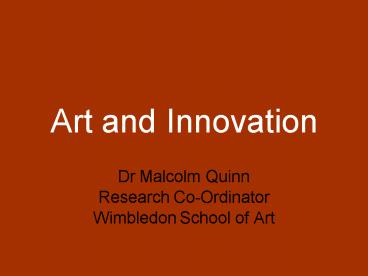Art and Innovation - PowerPoint PPT Presentation
1 / 10
Title:
Art and Innovation
Description:
Does looking at Fine Art practice with the eye of the researcher, enable us to ... used to counteract the effects of that violence irony, pastiche and parody. ... – PowerPoint PPT presentation
Number of Views:45
Avg rating:3.0/5.0
Title: Art and Innovation
1
Art and Innovation
- Dr Malcolm Quinn
- Research Co-Ordinator
- Wimbledon School of Art
2
- Does looking at Fine Art practice with the eye of
the researcher, enable us to see it as a field of
innovations? - If so, what kind of innovations does Fine Art
offer? - What models of research do these innovations
suggest?
3
(No Transcript)
4
Being convinced that Pascal was right to say
that true philosophy makes light of philosophy,
I have often regretted that academic proprieties
prevented me from taking this invitation
literally more than once I have wanted to fight
the symbolic violence that is exercised, firstly
on philosophers themselves, in the name of
philosophy, with the weapons most commonly used
to counteract the effects of that violenceirony,
pastiche and parody. I envied the freedom of
writers . . . or of the artists who from Duchamp
to Devatour, have, in their own artistic
practice, constantly subverted the belief in art
and artists (Pierre Bourdieu Pascalian
Meditations 200019972).
5
When he simply does what he has to do, the
sociologist breaks the enchanted circles of
collective denial of the social world by
academics. By working towards the return of the
repressed, by trying to know and make known what
the world of knowledge does not want to know,
especially about itself, he takes the risk of
appearing as the one who gives the game
awaybut to whom, except those with whom, in so
doing, he breaks ranks . . ? (Bourdieu
200219975)
6
Bourdieus Problem What do you do when your
scathing institutional critiques become part of
the larger narrative of institutional
success? Bourdieus Answer You look for an
example of an innovation that can actually
engender a moment of institutional failure
7
What was Duchamps Innovation in 1917? To
engineer a process where the mechanisms through
which the institution ensures that it cannot fail
(anyone can exhibit) guarantees the destruction
of the institution (The Society of Independent
Artists)
8
Why might such an innovation be required by
Bourdieu? While it never does harm to point out
that gender, nation or ethnicity or race are
social constructs, it is naive, even dangerous,
to suppose and suggest that one only has to
decontruct these social artefacts, in a purely
performative celebration of resistance, in
order to destroy them (Bourdieu 200219975)
9
Why arent such innovations in use in the arts,
humanities and social sciences? Firstly, the
dominant models of knowledge in these domains are
no-risk and all-inclusive (eg cultural
studies/visual culture) Secondly, the forms of
critique that those such as Bourdieu cite as
challenging established forms of knowledge and
belief are precisely those that threaten the
consistency of their own knowledge (academic
proprieties prevented me)
10
Is there any use for an innovation that produces
failure in a cultural situation where, no matter
how radical or transgressive, knowledge cannot
fail?































